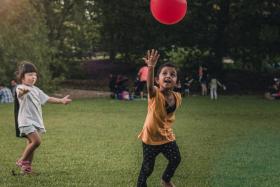World War II museum in Kent Ridge Park reopens on Thursday
Exhibition at Reflections at Bukit Chandu will be multimedia retelling of Malay Regiment's last stand
Never-before-seen footage of wartime hero Adnan Saidi is now part of an immersive exhibition at the revamped Reflections at Bukit Chandu that brings to life the valour of the Malay Regiment during World War II.
After three years of redevelopment, the World War II museum in Kent Ridge Park - sited not far from where the soldiers made their last stand - reopens on Thursday. Its exhibition will be a rich, multimedia retelling of the Malay Regiment's last stand on Pasir Panjang Hill against Japanese troops, moments before Singapore's surrender.
IMAGINE
Where visitors used to have just an unmoving bronze bust to imagine Lieutenant Adnan, who fought to his death in the Battle of Pasir Panjang in 1942, he is now brought to life with pre-war footage.
With touching vivacity, he is seen drilling his troops during a ceremonial parade.
First opened in 2002, Reflections at Bukit Chandu was closed in 2018 for major redevelopment works, and its experience has been updated to keep with the times.
Previously, hand-cut figures in a box with simple animation as background told the soldiers' story; now, a multimedia show takes up an entire room - with flashes of light, thunderous sound effects and an Edwin Thumboo poem. Augmented reality features will be installed later, the museum said.
Over three days in 1942, a 13,000-strong Japanese force was met with defiance by 1,400 soldiers of the Malay Regiment, an experimental creation by the British to give military training and employment to young Malays.
They fought valiantly, many to their deaths, and are to this day hailed as national heroes.
Lt Adnan, despite being mortally wounded, had fought on and was later caught, shot and bayoneted. His body is said to have been hung upside down from a tree.
Ms Chung May Khuen, director of the National Museum of Singapore, said: "Reflections at Bukit Chandu commemorates the tenacity and heroism of the Malay Regiment in the Battle of Pasir Panjang, a key moment in Singapore's World War II history.
"It complements the National Museum's World War II galleries and the recently revamped Changi Chapel and Museum's story of the prisoners of war and civilians interned at Changi prison camp. Together, these interlinked narratives piece together the story of World War II in Singapore."
Perhaps the most obvious change at Reflections at Bukit Chandu is that the iconic sculpture of the mortar crew of the Malay Regiment has been moved from the back of the building to the front.
The sculpture, which had been created based on archival footage, now announces the compound's purpose even before visitors enter the centre.
But the revamped museum also differs from its predecessor in another significant way.
There is a greater focus on the site's pre-war history - its role as an opium centre before the war and how inhabitants of the bungalow would have lived and looked out to see the bustling harbour.
Bukit Chandu means opium hill in Malay and, before the war, had an opium packing plant at its foot. Opium processed at a factory in Telok Blangah was sent to Pasir Panjang to be packed before being sold to smokers.
A lounge area helps visitors imagine how occupants of the bungalow would have enjoyed the sea breeze and view of the Singapore Strait.
Items excavated from the bungalow include a mysterious amulet, inscribed with Thai words, that is believed to belong to a Thai construction worker in the area.
Entry to the museum, which is now wheelchair- and stroller-accessible, is free for Singapore citizens and permanent residents.
Get The New Paper on your phone with the free TNP app. Download from the Apple App Store or Google Play Store now



